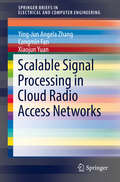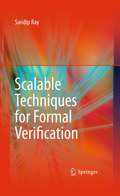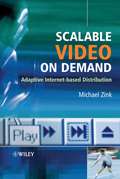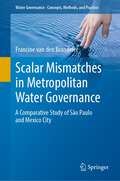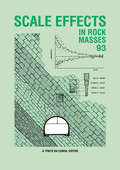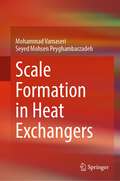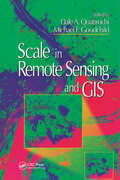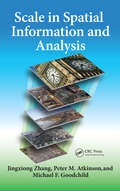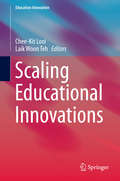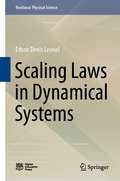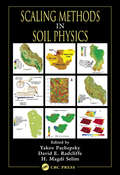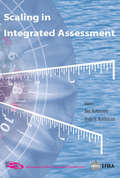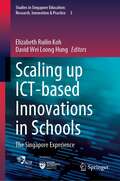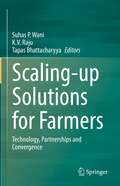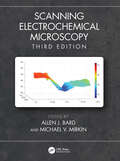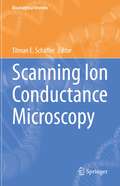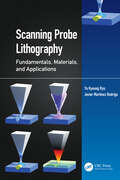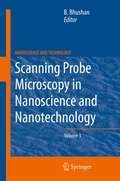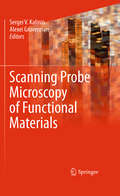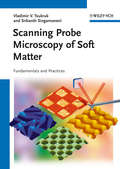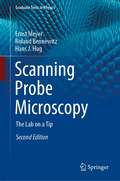- Table View
- List View
Scalable Signal Processing in Cloud Radio Access Networks (SpringerBriefs in Electrical and Computer Engineering)
by Ying-Jun Angela Zhang Congmin Fan Xiaojun YuanThis Springerbreif introduces a threshold-based channel sparsification approach, and then, the sparsity is exploited for scalable channel training. Last but not least, this brief introduces two scalable cooperative signal detection algorithms in C-RANs. The authors wish to spur new research activities in the following important question: how to leverage the revolutionary architecture of C-RAN to attain unprecedented system capacity at an affordable cost and complexity. Cloud radio access network (C-RAN) is a novel mobile network architecture that has a lot of significance in future wireless networks like 5G. the high density of remote radio heads in C-RANs leads to severe scalability issues in terms of computational and implementation complexities. This Springerbrief undertakes a comprehensive study on scalable signal processing for C-RANs, where ‘scalable’ means that the computational and implementation complexities do not grow rapidly with the network size. This Springerbrief will be target researchers and professionals working in the Cloud Radio Access Network (C-Ran) field, as well as advanced-level students studying electrical engineering.
Scalable Techniques for Formal Verification
by Sandip RayThis book presents state-of-the-art approaches to formal verification techniques to seamlessly integrate different formal verification methods within a single logical foundation. It should benefit researchers and practitioners looking to get a broad overview of the spectrum of formal verification techniques, as well as approaches to combining such techniques within a single framework. Coverage includes a range of case studies showing how such combination is fruitful in developing a scalable verification methodology for industrial designs. This book outlines both theoretical and practical issues involved in integrating different reasoning methods to work in concert, and current approaches to their resolution.
Scalable Video on Demand
by Michael ZinkIn recent years, the proliferation of available video content and the popularity of the Internet have encouraged service providers to develop new ways of distributing content to clients. Increasing video scaling ratios and advanced digital signal processing techniques have led to Internet Video-on-Demand applications, but these currently lack efficiency and quality.Scalable Video on Demand: Adaptive Internet-based Distribution examines how current video compression and streaming can be used to deliver high-quality applications over the Internet. In addition to analysing the problems of client heterogeneity and the absence of Quality of Service in the Internet, this book:assesses existing products and encoding formats;presents new algorithms and protocols for optimised on-line video streaming architectures;includes real-world application examples and experiments;sets out a practical 'toolkit' for Dynamically Reconfigurable Multimedia Distribution Systems.Written by an expert in the field of video distribution, Scalable Video on Demand: Adaptive Internet-based Distribution provides a novel approach to the design and implementation of Video-on-Demand systems for Software Engineers and researchers. It will also be useful for graduate students following Electronic Engineering and Computer Science courses.
Scalable and Secure Internet Services and Architecture (Chapman & Hall/CRC Computer and Information Science Series)
by Cheng-Zhong XuScalable and Secure Internet Services and Architecture provides an in-depth analysis of many key scaling technologies. Topics include: server clusters and load balancing; QoS-aware resource management; server capacity planning; Web caching and prefetching; P2P overlay network; mobile code and security; and mobility support for adaptive grid computi
Scalar Mismatches in Metropolitan Water Governance: A Comparative Study of São Paulo and Mexico City (Water Governance - Concepts, Methods, and Practice)
by Francine van den BrandelerThe book provides insights into the particular nature of water-related challenges in metropolitan regions of the Global South and the “scalar mismatches” that prevent their sustainable and inclusive development. It argues for the adoption of a metropolitan water governance approach to assess these challenges, including the drivers and institutions that shape these, and the policy instruments at river basin and urban scales that aim to address these. The cases of Mexico City and São Paulo, as two mega-cities with a wide ranging of water-related challenges, present lessons to other fast growing urban agglomerations on the variety of possible responses as well as obstacles to their effectiveness that receive little attention.
Scale Effects in Rock Masses 93
by A. PINTO DA CUNHAThe proceedings of the 2nd International Scale Effects in Rock Masses, held in Lisbon, June 25, 1993. The text includes coverage of scale effects in the determination of the deformability and strength of rock masses and scale effects in the determination of internal rock masses.
Scale Formation in Heat Exchangers
by Mohammad Varnaseri Seyed Mohsen PeyghambarzadehThis book brings together a wide range of current research to create a holistic understanding of fouling. It draws upon practical and laboratory experiences spanning many years. While offering an overview of various fouling types, the book's emphasis is on crystallization fouling, a facet seldom addressed in the existing literature. Furthermore, this book goes beyond theory by providing practical examples for heat exchanger design, incorporating the pivotal consideration of fouling's impact. It focuses especially on calcium salts such as calcium carbonate and calcium sulfate.Fouling formation represents a ubiquitous challenge across diverse industrial sectors, spanning oil, gas, petrochemicals, food, pharmaceuticals, and power generation. This encroaching fouling, prevalent within heating equipment, not only jeopardizes the integrity of machinery but also significantly saps energy resources. Consequently, extensive research efforts have been undertaken to comprehensively explore fouling formation through both experimental and theoretical avenues across various heating apparatuses. The book's mission is to facilitate a broader comprehension of crystallization fouling research, revealing the various factors influencing this form of fouling. Additionally, it critiques prior research endeavors, identifying their strengths and weaknesses while pinpointing potential avenues for future investigation
Scale Issues in Remote Sensing
by Qihao WengProvides up-to-date developments in the field of remote sensing by assessing scale issues in land surface, properties, patterns, and processes Scale is a fundamental and crucial issue in remote sensing studies and image analysis. GIS and remote sensing scientists use various scaling techniques depending on the types of remotely sensed images and geospatial data used. Scaling techniques affect image analysis such as object identification and change detection. This book offers up-to-date developments, methods, and techniques in the field of GIS and remote sensing and features articles from internationally renowned authorities on three interrelated perspectives of scaling issues: scale in land surface properties, land surface patterns, and land surface processes. It also visits and reexamines the fundamental theories of scale and scaling by well-known experts who have done substantial research on the topics. Edited by a prominent authority in the geographic information science community, Scale Issues in Remote Sensing: Offers an extensive examination of the fundamental theories of scale issues along with current scaling techniques Studies scale issues from three interrelated perspectives: land surface properties, patterns, and processes Addresses the impact of new frontiers in Earth observation technology (high-resolution, hyperspectral, Lidar sensing, and their synergy with existing technologies) and advances in remote sensing imaging science (object-oriented image analysis and data fusion) Prospects emerging and future trends in remote sensing and their relationship with scale Scale Issues in Remote Sensing is ideal as a professional reference for practicing geographic information scientists and remote sensing engineers as well as supplemental reading for graduate level students.
Scale in Remote Sensing and GIS (Remote Sensing Applications Ser.)
by Michael F. Goodchild Dale A. QuattrochiThe recent emergence and widespread use of remote sensing and geographic information systems (GIS) has prompted new interest in scale as a key component of these and other geographic information technologies. With a balanced mixture of concepts, practical examples, techniques, and theory, Scale in Remote Sensing and GIS is a guide for students and users of remote sensing and GIS who must deal with the issues raised by multiple temporal and spatial scales. Sixteen pages of full-color photographs help demonstrate key points made in the text.
Scale in Spatial Information and Analysis
by Michael F. Goodchild Jingxiong Zhang Peter AtkinsonNow ubiquitous in modern life, spatial data present great opportunities to transform many of the processes on which we base our everyday lives. However, not only do these data depend on the scale of measurement, but also handling these data (e.g., to make suitable maps) requires that we account for the scale of measurement explicitly. Scale in Spat
Scaling Educational Innovations
by Chee-Kit Looi Laik Woon TehThis volume stimulates critical discussions of the different variants of implementation, translation and scaling research approaches. It presents an integrated collection of different implementation and scaling studies that analyse the different facets of co-design, learning design, curriculum development, technology development, professional development and programme implementation. It also provides critical reflections on their impact and efficacies on transforming practices, informing policy-making, and theory derivation and improvement. The chapters in this volume will provide readers a deeper understanding of scaling of educational innovations in diverse socio-cultural contexts.
Scaling Laws in Dynamical Systems (Nonlinear Physical Science)
by Edson Denis LeonelThis book discusses many of the common scaling properties observed in some nonlinear dynamical systems mostly described by mappings. The unpredictability of the time evolution of two nearby initial conditions in the phase space together with the exponential divergence from each other as time goes by lead to the concept of chaos. Some of the observables in nonlinear systems exhibit characteristics of scaling invariance being then described via scaling laws. From the variation of control parameters, physical observables in the phase space may be characterized by using power laws that many times yield into universal behavior. The application of such a formalism has been well accepted in the scientific community of nonlinear dynamics. Therefore I had in mind when writing this book was to bring together few of the research results in nonlinear systems using scaling formalism that could treated either in under-graduation as well as in the post graduation in the several exact programs but no earlier requirements were needed from the students unless the basic physics and mathematics. At the same time, the book must be original enough to contribute to the existing literature but with no excessive superposition of the topics already dealt with in other text books. The majority of the Chapters present a list of exercises. Some of them are analytic and others are numeric with few presenting some degree of computational complexity.
Scaling Methods in Soil Physics
by Yakov Pachepsky David E. Radcliffe H. Magdi SelimThe scaling issue remains one of the largest problems in soil science and hydrology. This book is a unique compendium of ideas, conceptual approaches, techniques, and methodologies for scaling soil physical properties. Scaling Methods in Soil Physics covers many methods of scaling that will be useful in helping scientists across a range of soil-rel
Scaling in Integrated Assessment
by Dale S. Rothman Jan RotmansA collection of papers prepared for the European Forum on Integrated Environmental Assessment's (EFIEA) Policy Workshop on Scaling Issues in Integrated Assessment, held from 12-19 July 2000.
Scaling up ICT-based Innovations in Schools: The Singapore Experience (Studies in Singapore Education: Research, Innovation & Practice #3)
by Elizabeth Ruilin Koh David Wei Loong HungThis collected book is about the eduLab projects, an initiative with focus on Scaling Change through Apprenticising and Ecological Leadership, designed to surface and spread ground-up information and communication technology-based pedagogical innovations. It presents the goals and rationale behind eduLab, an overview of the research projects conducted by its principal investigators during its funding tenure, as well as synthesizing thoughts on the entire endeavor. This book not only marks the achievements of the eduLab programme but also serves as inspiration for future projects. It presents Singapore education in action – a continually evolving and adapting education system that delivers a system well known for its high quality as much as it is forward-looking.
Scaling-up Solutions for Farmers: Technology, Partnerships and Convergence
by Tapas Bhattacharyya K. V. Raju Suhas P. WaniThis book provides a unique account of cross-sectoral innovations through efficient partnerships based on the hands-on experience of internationally renowned contributors specialised in the field of Science of Delivery. The challenges and lessons learned from large development initiatives based in Asia, and from the work undertaken by international research institutions, such as the FAO, are brought together in this book to benefit development agencies, policy makers, corporates, post graduate students, farmers’ organizations, and those involved in supplying agricultural inputs and/or buying agricultural produce, particularly in developing countries within Asia and Africa. Through a number of case studies the book describes how the consortium approach of capacity building for equitable and efficient benefits, collective action, and convergence, will benefit millions of small farm-holders in different regions of Asia
Scanning Electrochemical Microscopy
by Allen J. BardBecause of its simplicity of use and quantitative results, Scanning Electrochemical Microscopy (SECM) has become an indispensable tool for the study of surface reactivity. The fast expansion of the SECM field over several years has been fueled by the introduction of new probes, commercially available instrumentation, and new practical applications. Scanning Electrochemical Microscopy, Third Edition offers essential background and in-depth overviews of specific applications in self-contained chapters. The vitality and growing popularity of SECM over the past 30+ years have largely been determined by its versatility and capability to remain useful in the changing scientific and technological environments. New applications reported during the last decade reflect significant current activity in biomedical and energy-related research. This thoroughly updated edition provides up-to-date comprehensive reviews of different aspects of SECM. New chapters by renowned professionals in the field cover recent advances in different areas of SECM including nanoSECM, surface reactions and films, batteries, and fuel cells. Expanded coverage of electrocatalysis and surface interrogation as well as photoelectrochemistry and photoelectrocatalysis are also provided. Useful for a broad range of interdisciplinary research—from biological systems to nanopatterning—this book is invaluable to all interested in learning and applying SECM.
Scanning Force Microscopy of Polymers
by Holger Schönherr G. Julius VancsoThis lab manual introduces the reader to scanning force microscopy of polymers based on a practice-oriented approach. It begins with a broad introduction to the necessary background of SFM, including intermolecular forces and various SFM imaging modes. "Scanning Force Microscopy of Polymers" is developed in a didactically clear and easily understandable style. The application of SFM to visualize and study polymers is exemplified by numerous case studies, including experimental protocols. In addition, the book helps the reader to develop a conscious and critical understanding of SFM data. This approach enables the reader to acquire the knowledge and experimental skills that are necessary to understand and obtain good and reliable SFM results within the shortest time possible.
Scanning Ion Conductance Microscopy (Bioanalytical Reviews #3)
by Tilman E. SchäfferThis book provides a selection of recent developments in scanning ion conductance microscopy (SICM) technology and applications. In recent years, SICM has been applied in an ever-increasing number of areas in the bioanalytical sciences. SICM is based on an electrolyte-filled nanopipette with a nanometer-scale opening, over which an electric potential is applied. The induced ion current is measured, which allows to directly or indirectly quantify various physical quantities such as pipette-sample distance, ion concentration, sample elastic modulus among many others. This makes SICM well suited for applications in electrolytes - most prominently for the study of live cells.This book starts with a historic overview starting from the days of the invention of SICM by Paul Hansma at the University of California at Santa Barbara in 1989. SICM is a member of the family of scanning probe microscopies. It is related to another prominent member of the family, atomic force microscopy (AFM), which has found application in almost any field of nanoscale science. The advantages and disadvantages of SICM over AFM are also outlined. One of the most effective and break-through applications of SICM nanopipettes is in electrochemistry. The different routes and applications for doing electrochemistry using nanopipettes are also discussed. In addition the book highlights the ability of SICM for surface positioning with nanometer precision to open up new vistas in patch clamp measurements subcellular structures. Finally the book presents one research area where SICM has been making a lot of contributions, cardiac research and the endeavors to combine SICM with super-resolution optical microscopy for highest-resolution joint topography and functional imaging.
Scanning Probe Lithography: Fundamentals, Materials, and Applications (Emerging Materials and Technologies)
by Yu Kyoung Ryu Javier Martinez RodrigoThe most complete book available on scanning probe lithography (SPL), this work details the modalities, mechanisms, and current technologies, applications, and materials on which SPL can be performed. It provides a comprehensive overview of this simple and cost-effective technique, which does not require clean room conditions and can be performed in any lab or industry facility to achieve high-resolution and high-quality patterns on a wide range of materials: biological, semiconducting, polymers, and 2D materials. • Introduces historical background of SPL, including evolution of the technique and tools • Explains the mechanism of sample modification/manipulation, types of AFM tips, technical parts of the experimental setup, and materials on which the technique can be applied • Shows the different types of devices and structures fabricated by SPL, together with the processing steps • Contains a complete and state-of-the art package of examples and different approaches, performed by different international research groups • Summarizes strengths, limitations, and potential of SPL This book is aimed at advanced students, technicians, and researchers in materials science, microelectronics, and others working with lithographic techniques and fabrication processes.
Scanning Probe Microscopes: Applications in Science and Technology
by K. S. BirdiScanning Probe Microscopes: Applications in Science and Technology explains, analyzes, and demonstrates the most widely used microscope in the family of microscopes -- the scanning probe microscope. Beginning with an introduction to the development of SPMs, the author introduces the basics of scanning tunneling and atomic force microscopes (STMs an
Scanning Probe Microscopy in Nanoscience and Nanotechnology 3
by Bharat BhushanThis book presents the physical and technical foundation of the state of the art in applied scanning probe techniques. It constitutes a timely and comprehensive overview of SPM applications. The chapters in this volume relate to scanning probe microscopy techniques, characterization of various materials and structures and typical industrial applications, including topographic and dynamical surface studies of thin-film semiconductors, polymers, paper, ceramics, and magnetic and biological materials. The chapters are written by leading researchers and application scientists from all over the world and from various industries to provide a broader perspective.
Scanning Probe Microscopy of Functional Materials
by Sergei V. Kalinin Alexei GruvermanThe goal of this book is to provide a general overview of the rapidly developing field of novel scanning probe microscopy (SPM) techniques for characterization of a wide range of functional materials, including complex oxides, biopolymers, and semiconductors. Many recent advances in condensed matter physics and materials science, including transport mechanisms in carbon nanostructures and the role of disorder on high temperature superconductivity, would have been impossible without SPM. The unique aspect of SPM is its potential for imaging functional properties of materials as opposed to structural characterization by electron microscopy. Examples include electrical transport and magnetic, optical, and electromechanical properties. By bringing together critical reviews by leading researchers on the application of SPM to to the nanoscale characterization of functional materials properties, this book provides insight into fundamental and technological advances and future trends in key areas of nanoscience and nanotechnology.
Scanning Probe Microscopy of Soft Matter: Fundamentals and Practices
by Vladimir V. Tsukruk Srikanth SingamaneniWell-structured and adopting a pedagogical approach, this self-contained monograph covers the fundamentals of scanning probe microscopy, showing how to use the techniques for investigating physical and chemical properties on the nanoscale and how they can be used for a wide range of soft materials. It concludes with a section on the latest techniques in nanomanipulation and patterning. This first book to focus on the applications is a must-have for both newcomers and established researchers using scanning probe microscopy in soft matter research. From the contents: * Atomic Force Microscopy and Other Advanced Imaging Modes * Probing of Mechanical, Thermal Chemical and Electrical Properties * Amorphous, Poorly Ordered and Organized Polymeric Materials * Langmuir-Blodgett and Layer-by-Layer Structures * Multi-Component Polymer Systems and Fibers * Colloids and Microcapsules * Biomaterials and Biological Structures * Nanolithography with Intrusive AFM Tipand Dip-Pen Nanolithography * Microcantilever-Based Sensors
Scanning Probe Microscopy: The Lab on a Tip (Graduate Texts in Physics)
by Ernst Meyer Roland Bennewitz Hans J. HugWritten by three leading experts in the field, this textbook describes and explains all aspects of the scanning probe microscopy. Emphasis is placed on the experimental design and procedures required to optimize the performance of the various methods. Scanning Probe Microscopy covers not only the physical principles behind scanning probe microscopy but also questions of instrumental designs, basic features of the different imaging modes, and recurring artifacts. The intention is to provide a general textbook for all types of classes that address scanning probe microscopy. Third year undergraduates and beyond should be able to use it for self-study or as textbook to accompany a course on probe microscopy. Furthermore, it will be valuable as reference book in any scanning probe microscopy laboratory. Novel applications and the latest important results are also presented, and the book closes with a look at the future prospects of scanning probe microscopy, also discussing related techniques in nanoscience. Ideally suited as an introduction for graduate students, the book will also serve as a valuable reference for practising researchers developing and using scanning probe techniques.
